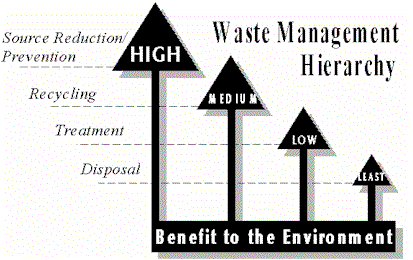Pollution prevention became a national policy with the Pollution Prevention Act of 1990. The Act established the waste management hierarchy (below) whereby wastes should be prevented or reduced at the source whenever feasible and safe disposal is the option of last resort. Preventing pollution in agricultural and vocational teaching labs is important.
Pollution Prevention IS:
Any activity that reduces or eliminates pollutants prior to recycling, treatment, control or disposal, such as:
- good housekeeping
- in-process recycling
- inventory control
- product substitution
- process changes
- waste segregation
Pollution Prevention IS NOT:
- disposal
- off-site recycling
- pollution treatment
- end-of-pipe control

Why P2 for agricultural and vocational educators?
Agriculture and industry rely on clean, safe water, soil, air and an ongoing supply of natural resources. Plus, when you take steps to prevent pollution, you are also reducing wastes, conserving energy, saving money and improving lab and workshop safety. Understanding the philosophy and practices of P2 allows us to do this.
Practicing Pollution Prevention in the classroom and teaching laboratory is important because it:
- makes an immediate contribution by reducing wastes and conserving energy today
- enhances personal safety in your shop for students and instructors
- teaches students values and practices they will take with them into their careers
Agricultural educators in Colorado, Wyoming, Utah, Montana and North and South Dakota face some definite barriers in managing waste. Because of the geographic isolation of many communities in this region, it is often difficult to take advantage of recycling and proper disposal. This is why pollution prevention is especially important. When pollution prevention is practiced, the amount of waste is drastically reduced. Proper disposal methods do exist for unavoidable wastes, and should be practiced.
Where should educators apply P2?
Pollution prevention can be incorporated into everyday activities and in agricultural and vocational laboratories P2 can be applied in the classroom, mechanics lab, wood lab, greenhouses and farm plots, animal confinement areas, welding/metals lab, painting booths/areas, and any other similar teaching areas. These labs can produce the same wastes as their counterparts in industry and production agriculture do.
Instructors, students and administrators can be partners in a successful P2 program, not only reducing physical waste, but also conserving resources such as energy and water.